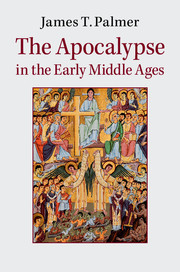Book contents
- Frontmatter
- Dedication
- Contents
- List of figures
- List of maps
- Acknowledgements
- List of abbreviations
- Maps
- Introduction
- 1 The end of civilisation (c. 380–c. 575)
- 2 The new urgency (c. 550–c. 604)
- 3 The ends of time and space (c. 600–c. 735)
- 4 Pseudo-Methodius and the problem of evil (c. 680–c. 800)
- 5 Charlemagne, pater Europae (c. 750–c. 820)
- 6 A Golden Age in danger (c. 820–c. 911)
- 7 The Year 1000 and other apocalypticisms (c. 911–c. 1033)
- Conclusion
- Select bibliography
- Index of manuscript references
- General index
Conclusion
the end (c. 400–c. 1033)
Published online by Cambridge University Press: 05 November 2014
- Frontmatter
- Dedication
- Contents
- List of figures
- List of maps
- Acknowledgements
- List of abbreviations
- Maps
- Introduction
- 1 The end of civilisation (c. 380–c. 575)
- 2 The new urgency (c. 550–c. 604)
- 3 The ends of time and space (c. 600–c. 735)
- 4 Pseudo-Methodius and the problem of evil (c. 680–c. 800)
- 5 Charlemagne, pater Europae (c. 750–c. 820)
- 6 A Golden Age in danger (c. 820–c. 911)
- 7 The Year 1000 and other apocalypticisms (c. 911–c. 1033)
- Conclusion
- Select bibliography
- Index of manuscript references
- General index
Summary
The argument of this book has been that apocalyptic thought was an important cultural resource used in the early Middle Ages for changing the world. Christ himself had promised that the End would come, soon but unexpectedly, so it would have taken an unusual Christian in these important centuries to deny Christ on the matter. The issue that mattered was how apocalypse called the mind’s attention to reform. Speculation – second-guessing God – was forbidden. Beyond that, apocalypse provided the language, the incentive and the time-frame which helped to stimulate people to strive for better things. Crises came: Rome ‘fell’, external forces attacked, members of the Church could become corrupt, heresies could rise, the weather and stars could prove less than predictable. Experts offered frameworks for interpretation which encouraged action motivated by the greatest of hopes and fears – but fears that were to be responded to with bravery, not despondency. None of this is to say that the early Middle Ages was uniquely beset by terrible crises. Rather, what I hope to have provided is an extended case study on the ways in which people have used anxiety and reflection on finality to make a difference, to mobilise and to stimulate change. In this brief conclusion, I shall try and bring some of the threads together.
What is the End?
There would be only one ending. Whichever way one got there, the Last Judgement and the destruction of the current physical world were inevitable. The moral dimension of this was equally clear because the very fact of Judgement ensured that Christians knew they would eventually have to be accountable for their sins and would (hopefully) act accordingly. What followed, beyond the End, was unchanging perfection for the saved or eternal damnation for those who could not make amends. Apocalypse and eschatology were parts of a body of thought – singular but complex – which explained to people how they would get from pre-Judgement to post-Judgement, from history to post-history. The whole package revolved around visionary material, either entering into the spirit of, or carefully explaining, the mystical symbolism and oblique predictions espoused by the Old Testament prophets, Christ, John of Patmos and the apocryphal revelations of Paul, Timothy and others. Visions of the End and their interpretation fundamentally communicated future expectations to prepare people for their inescapable fate.
- Type
- Chapter
- Information
- The Apocalypse in the Early Middle Ages , pp. 227 - 235Publisher: Cambridge University PressPrint publication year: 2014



